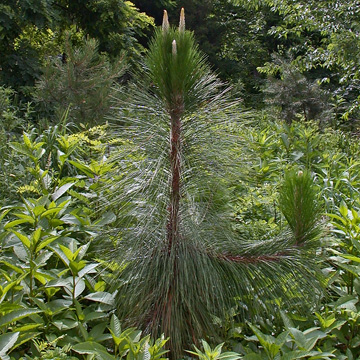

Pinus palustris - (image 1 of 2)
Taxonomy
Family: Pinacea
Habitat
Moist or dry, sandy soil.
Associates
Distribution
Southeast VA to FL and TX, primarily on the coastal plain, less commonly on the piedmont.
Morphology
Upright, evergreen conifer to 30 m; bark becoming orange-brown, with rough, scaly plates; twigs very stout; winter buds large, to 2.5 cm, covered with silvery-white, fringed scales; leaves in fascicles of 3, closely crowded at the ends of the branches, persistent 2 years, light green, soft, often drooping, 20-30(-50) cm long; cones divergent, often pendent, conic-oblong, 15-25 cm long and 5-6 cm thick, opening at maturity and soon falling; apophysis thick and prominently ridged, the umbo elevated, with a small, reflexed spine; seeds about 4 cm long.
Notes
Flowers NA
Wetland indicator: NA
The only pine in our range with needles often over 25 cm long. Pinus taeda L. (Loblolly Pine) has needles 14-25 cm long and smaller cones (7-13 cm long vs. 15-25 cm long).
The plants in these images are just coming out of the grass stage which can last for 5-12 years. During the grass stage plants are resistant to fire; the stem is very short, with plants appearing as a dense mound of long needles.
References
Gleason, Henry A. and A. Cronquist. 1991. Manual of Vascular Plants of Northeastern United States and Adjacent Canada. Second Ed.
The New York Botanical Garden. Bronx, NY
USDA, NRCS. 2002. The PLANTS Database, Version 3.5 (http://plants.usda.gov).
National Plant Data Center, Baton Rouge, LA 70874-4490 USA.
|
Michael Hough © 2018 |